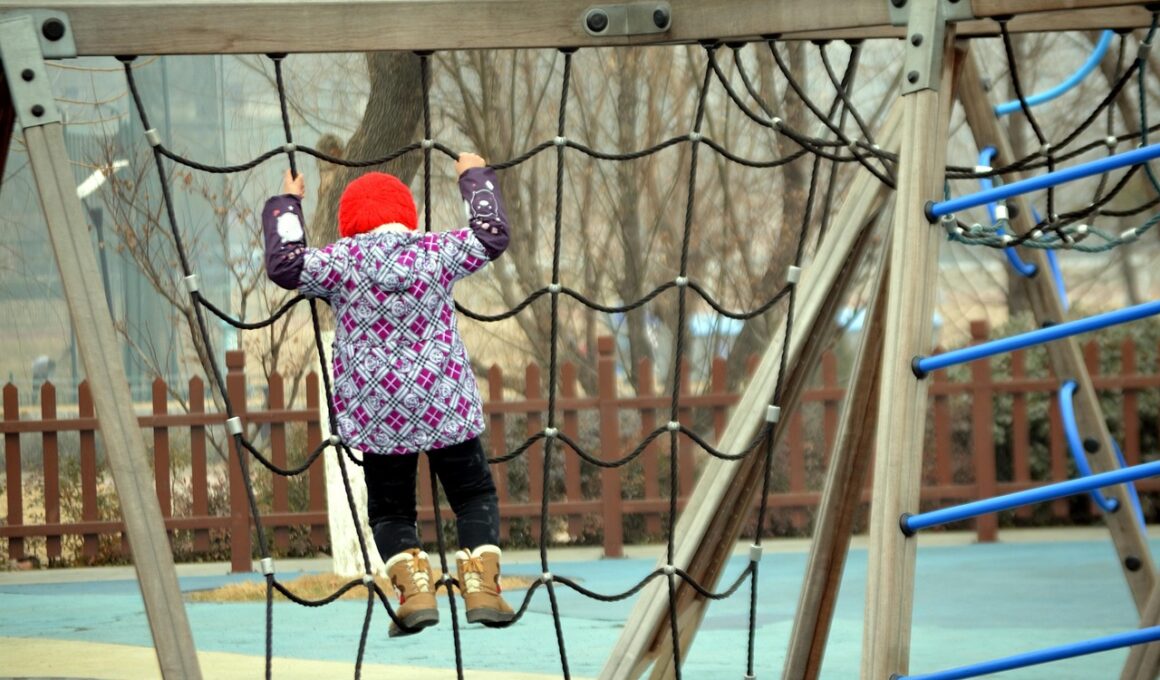How to Incorporate Fitness Equipment into Kids’ School PE Programs
Integrating fitness equipment into kids’ school physical education (PE) programs is essential for fostering a love of physical activity. Schools need to evaluate their current curriculum and identify opportunities where fitness equipment can enhance students’ engagement. Consider organizing brainstorming sessions with PE teachers, coaches, and students to discuss preferred types of equipment. Create a selection of appealing equipment such as balance beams, agility ladders, and child-sized weights. These inclusions promote balance, coordination, and strength while ensuring safety. Small groups can rotate through stations, keeping student interest high and encouraging teamwork. Regular assessments of each student’s progress can also identify what equipment works best for them, ensuring that every child benefits equally. Furthermore, the use of fitness equipment can help in developing essential life skills, promoting perseverance and discipline among young learners. Effective communication about the benefits of this equipment to parents can foster support. Encouraging participation in school-wide challenges can further motivate children. With the right planning and dedication, fitness equipment becomes an invaluable tool for promoting wellness and fitness in schools.
Another strategy to incorporate fitness equipment is by utilizing grant opportunities. Many organizations offer funding for schools aiming to enhance fitness programs. By actively pursuing these grants, schools can acquire quality fitness gear that might otherwise be financially unattainable. Building partnerships with local businesses and fitness organizations can also provide an additional resource for equipment donations. Creating sponsorship opportunities allows local businesses to contribute positively to their communities. Schools can also host fundraising initiatives focused on fitness, such as fun runs or fitness fairs, engaging both students and families. This collaborative effort not only raises funds but also builds community support for fitness initiatives. Introducing fitness challenges or competitions could enhance excitement and engagement with the equipment. For example, schools can establish a “fitness month,” inviting students to log their fitness activities and utilize available equipment. Recognizing achievements at school assemblies fosters a sense of pride and accomplishment among students. These collaborative approaches ensure sustainability for school fitness programs. Additionally, promoting positive messages about fitness through school events can encourage lifelong healthy habits among children.
Curriculum Integration for Fitness Equipment
The integration of fitness equipment in curricular activities serves to blend learning with physical exercise. Schools should empower teachers to create lesson plans that include fitness activities relevant to various subjects. For example, math lessons can incorporate counting fitness activities, while language arts can focus on reading health-related material. Such interdisciplinary approaches not only maintain engagement but heighten awareness about healthy living. Involving students in equipment selection fosters ownership and responsibility, increasing the likelihood of continued participation. Additionally, incorporating seasonal fitness themes can enhance motivation throughout the year. Introducing new equipment at the beginning of each term can spark excitement among students about upcoming PE classes. Regular workshops and training for teachers on how to effectively utilize this equipment are vital. This ensures teachers feel confident and prepared to implement new strategies. Furthermore, establishing fitness clubs or after-school programs can provide extra opportunities for students interested in pursuing fitness. Creating inclusive environments for all students also ensures that no child feels left out, allowing diverse abilities and interests to flourish. These measures will contribute to a more robust fitness culture within the educational environment.
Physical activity should be a fun and engaging experience for all students. Incorporating technology, such as fitness apps and trackers, can boost interest and participation. Schools can leverage these technologies to set fitness goals and track progress, making children feel more connected to their wellness journey. Teachers can integrate tech tools alongside traditional equipment, utilizing digital platforms to facilitate fitness challenges or log activities. Instructors can also lead group discussions about setting personal fitness goals and inspire students to take ownership of their health. Highlighting success stories from classmates who utilize fitness equipment can motivate others. Creating an environment that celebrates fitness achievements encourages all students to embrace physical activity wholeheartedly. Hosting regular fitness events such as ‘Family Fitness Nights’ can increase the school community’s involvement and participation. This gathering encourages families to explore equipment together, creating lasting memories. Schools can utilize theme days or weeks to maintain excitement around fitness. These events allow for the introduction of new types of equipment while providing a platform for students to showcase their skills and abilities. Continued encouragement is essential to nurturing the next generation of health-conscious individuals.
Safety Considerations with Kids’ Fitness Equipment
Safety cannot be overlooked when incorporating fitness equipment in school PE programs. Establishing safety guidelines around usage is paramount. Schools should regularly inspect all equipment to ensure it is in good condition, thus preventing injury risks for children. Training workshops for teachers on safety practices are essential for maintaining a secure environment. Additionally, implementing a buddy system can enhance safety, encouraging children to support each other while using the equipment. It fosters teamwork and ensures help is readily available in case of an accident. Parents should also be informed about the safety procedures in place, reassuring them about their children’s wellbeing during physical activities. Providing clear instructions and demonstrations for each type of equipment ensures that students understand how to use them correctly. Incorporating warm-up and cool-down sessions can also minimize injury risk, teaching children the importance of proper preparation before exercise. Equally, monitoring usage time and promoting breaks helps prevent fatigue. Ensuring proper footwear and attire among students will contribute further to their safety. Following these precautions promotes a culture of health and physical activity, where students feel secure to explore fitness opportunities.
Another crucial aspect of successfully incorporating fitness equipment into school PE programs is fostering collaboration among staff, parents, and health professionals. Engaging with experts can provide valuable insights into selecting equipment that meets children’s developmental needs. Schools can benefit from collaborating with local gyms and fitness centers, where specialists can provide support through classes or workshops for students and teachers alike. By inviting guest speakers to discuss health and fitness, students gain exposure to diverse perspectives on well-being. Establishing a health committee within the school can create a structured approach to wellness initiatives, ensuring all voices are heard in the decision-making process. Collaborative events such as community fitness days can strengthen the relationship between schools and local organizations while promoting fitness within the community. For example, featuring interactive fitness demonstrations with the fitness equipment helps children visualize its use and benefits. Encouraging family participation in these events increases awareness of the importance of physical activity at home. Utilizing feedback from families and the wider community about the fitness programs can help schools refine and enhance their approach continuously. These collaborative efforts will increase the overall effectiveness of fitness initiatives.
Long-term Benefits of Fitness Equipment in Education
Incorporating fitness equipment into children’s education offers long-term benefits that extend beyond immediate physical health. Children who are regularly engaged in physical activity develop positive habits that often last a lifetime. Studies have shown that physical activity enhances cognitive function, focusing better on academic tasks. Moreover, students involved in fitness programs typically experience improved academic performance overall. Developing crucial life skills like teamwork, leadership, and discipline during physical activities also proves invaluable as children grow. Schools that prioritize fitness programs tend to witness lower absenteeism, leading to better education outcomes. Fostering a culture of health among children can decrease obesity rates, positively impacting public health. Additionally, encouraging children to embrace physical fitness early makes them more likely to continue these practices into adulthood, which can lead to longer, healthier lives. Schools can further support this initiative by establishing robust after-school fitness programs or clubs that offer additional opportunities for physical activity. Regularly evaluating these programs will ensure children consistently benefit from their fitness experiences. By laying a strong foundation for fitness early on, educators can significantly influence students’ health and well-being for years to come.
In conclusion, integrating fitness equipment into school PE programs is pivotal to fostering a positive relationship with health and wellness for children. It requires thoughtful planning, collaboration, and commitment from teachers, parents, and the wider community. By utilizing grants and partnerships to secure quality equipment, schools can ensure that all students have access to vital resources. Interdisciplinary curriculum integration enhances the overall experience, making learning enjoyable and impactful. Prioritizing safety remains crucial to avoid potential injuries, while ongoing communication with all stakeholders strengthens the support network around these programs. Schools must actively promote health, encourage physical activity, and adapt to meet the needs of all students. Celebrating success and encouraging participation will help maintain motivation across fitness initiatives. Engaging with local health professionals can also add credibility and expertise to PE programs, ensuring that children are equipped with the essential knowledge to lead healthier lifestyles. Ultimately, these efforts will yield long-term benefits for both individual students and society as a whole. By committing to these strategies, schools can pave the way for healthier generations, setting students on the path to an active and successful future.


